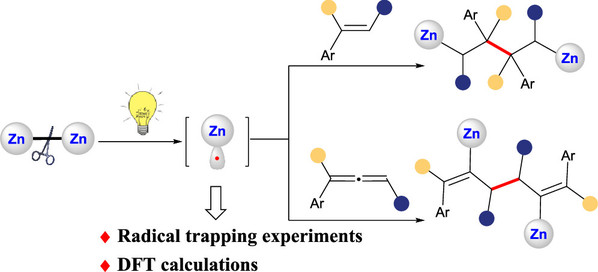Reductive Dimerization of Alkenes and Allenes Enabled by Photochemically Activated Zinc–Zinc Bonded Compounds
Shuilian Xu1, Qiujie Wang1, Thayalan Rajeshkumar2,3, Shengjie Jiang1, Laurent Maron2,3*, Xin Xu1*(徐信)
1Key Laboratory of Organic Synthesis of Jiangsu Province, College of Chemistry, Chemical Engineering and Materials Science, Soochow University, Suzhou 215123, P. R. China
2LPCNO, CNRS, Université PaulSabatier, Toulouse 31077, France
3LPCNO, INSA, Université Paul Sabatier, Toulouse 31077, France
J. Am. Chem. Soc. 2024, 146, 19590−19598
Abstract: Metal radicals have shown versatile reactivity in modern synthetic chemistry. However, the use of zinc radicals for molecular synthesis has been barely explored. Here, we show that a transient zinc radical can be formed through photoactivation of a zinc–zinc bonded compound, which is able to mediate the selective dimerization of alkenes and allenes. Treatment of dizinc compounds [L2Zn2] [L = CH3C(2,6-iPr2C6H3N)CHC(CH3)(NCH2CH2PR2); R = Ph (LPh) or iPr (LiPr)] with a diverse array of aromatic alkenes under UV irradiation (365 nm) facilely afforded the head-to-head coupling products, i.e., 1,4-dizinciobutanes in high yields. In addition, arylallenes could also be selectively dimerized by the dizinc compound to give 2,5-dizincyl-functionalized 1,5-hexadienes under the same conditions. Control reactions of [LPh2Zn2] in the presence of UV irradiation isolated a zinc phenyl complex and a trimeric zinc phosphide complex resulting from C–P bond cleavage at the tridentate ligand. Reactions of photoactivated dizinc compounds with organic spin traps, i.e., 2,2,6,6-tetramethyl-1-piperidinyloxy (TEMPO) and 2,2′-bipyridine (2,2′-bpy), successfully isolated zinc radical trapping products [LZnOTEMP] and [LPhZn(2,2′-bpy)·–], respectively. The profile of alkene dimerization was elucidated by density functional theory calculations, which confirmed that a transient zinc radical [LZn·] was initially generated through homolytic Zn–Zn bond cleavage via photoactivation followed by single-electron transfer and radical dimerization. The unique selectivity of the current reaction was also studied computationally.

链接://pubs.acs.org/doi/10.1021/jacs.4c07390